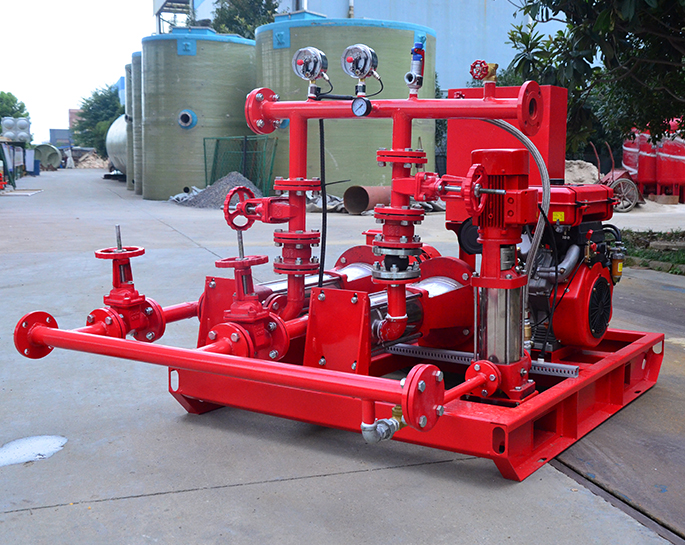How are fire pumps protected against water hammer, and what measures are taken to prevent this phenomenon?
Feb 05, 2024
Share:
Water hammer, also known as hydraulic shock, is a phenomenon that occurs when there is a sudden change in fluid flow, resulting in a pressure surge within a piping system. This can be a concern for fire pump systems, and various measures are taken to prevent or mitigate water hammer. Here are some common methods used to protect fire pumps against water hammer:
1. **Slow Closing Valves:** Installing slow closing valves, such as check valves with adjustable closing speeds, helps prevent the sudden closure of valves and reduces the likelihood of water hammer. These valves close gradually, minimizing the impact on the piping system.
2. **Water Hammer Arrestors:** Water hammer arrestors, also known as shock absorbers or surge suppressors, are devices designed to absorb the energy generated by water hammer. These devices typically contain a cushion of air or a compressible material that absorbs the shock, preventing it from traveling through the piping system.
3. **Pressure Relief Valves:** Pressure relief valves are set to open at a predetermined pressure, allowing excess pressure to be released from the system. This can help prevent water hammer by avoiding the buildup of excessive pressure during sudden changes in flow.
4. **Piping Layout and Design:** Proper design and layout of the piping system can help mitigate water hammer. This includes the use of gradual bends and curves in the piping, avoiding sharp angles, and ensuring that the system is properly sized to handle the expected flow rates.
5. **Variable Speed Drives:** Some fire pump systems use variable speed drives to control the speed of the pump motor. By gradually adjusting the pump speed, these systems can minimize sudden changes in flow and reduce the risk of water hammer.
6. **Water Supply Control:** Controlling the opening and closing of water supply valves in a gradual manner can help prevent water hammer. Rapid changes in valve positions can lead to sudden changes in flow and pressure, contributing to water hammer.
7. **System Modeling and Analysis:** Performing hydraulic modeling and analysis of the fire pump system can help identify potential areas where water hammer may occur. Engineers can then implement design changes or additional protective measures based on the analysis.
8. **Educational and Operational Procedures:** Proper training of personnel on the operation and maintenance of the fire pump system is essential. Operators should be aware of the potential for water hammer and follow operational procedures that minimize the risk.
By combining these measures, fire pump systems can be designed and operated in a way that minimizes the risk of water hammer, ensuring the safety and reliability of the overall firefighting system.

1. **Slow Closing Valves:** Installing slow closing valves, such as check valves with adjustable closing speeds, helps prevent the sudden closure of valves and reduces the likelihood of water hammer. These valves close gradually, minimizing the impact on the piping system.
2. **Water Hammer Arrestors:** Water hammer arrestors, also known as shock absorbers or surge suppressors, are devices designed to absorb the energy generated by water hammer. These devices typically contain a cushion of air or a compressible material that absorbs the shock, preventing it from traveling through the piping system.
3. **Pressure Relief Valves:** Pressure relief valves are set to open at a predetermined pressure, allowing excess pressure to be released from the system. This can help prevent water hammer by avoiding the buildup of excessive pressure during sudden changes in flow.
4. **Piping Layout and Design:** Proper design and layout of the piping system can help mitigate water hammer. This includes the use of gradual bends and curves in the piping, avoiding sharp angles, and ensuring that the system is properly sized to handle the expected flow rates.
5. **Variable Speed Drives:** Some fire pump systems use variable speed drives to control the speed of the pump motor. By gradually adjusting the pump speed, these systems can minimize sudden changes in flow and reduce the risk of water hammer.
6. **Water Supply Control:** Controlling the opening and closing of water supply valves in a gradual manner can help prevent water hammer. Rapid changes in valve positions can lead to sudden changes in flow and pressure, contributing to water hammer.
7. **System Modeling and Analysis:** Performing hydraulic modeling and analysis of the fire pump system can help identify potential areas where water hammer may occur. Engineers can then implement design changes or additional protective measures based on the analysis.
8. **Educational and Operational Procedures:** Proper training of personnel on the operation and maintenance of the fire pump system is essential. Operators should be aware of the potential for water hammer and follow operational procedures that minimize the risk.
By combining these measures, fire pump systems can be designed and operated in a way that minimizes the risk of water hammer, ensuring the safety and reliability of the overall firefighting system.


.png)
.png)

.png)


